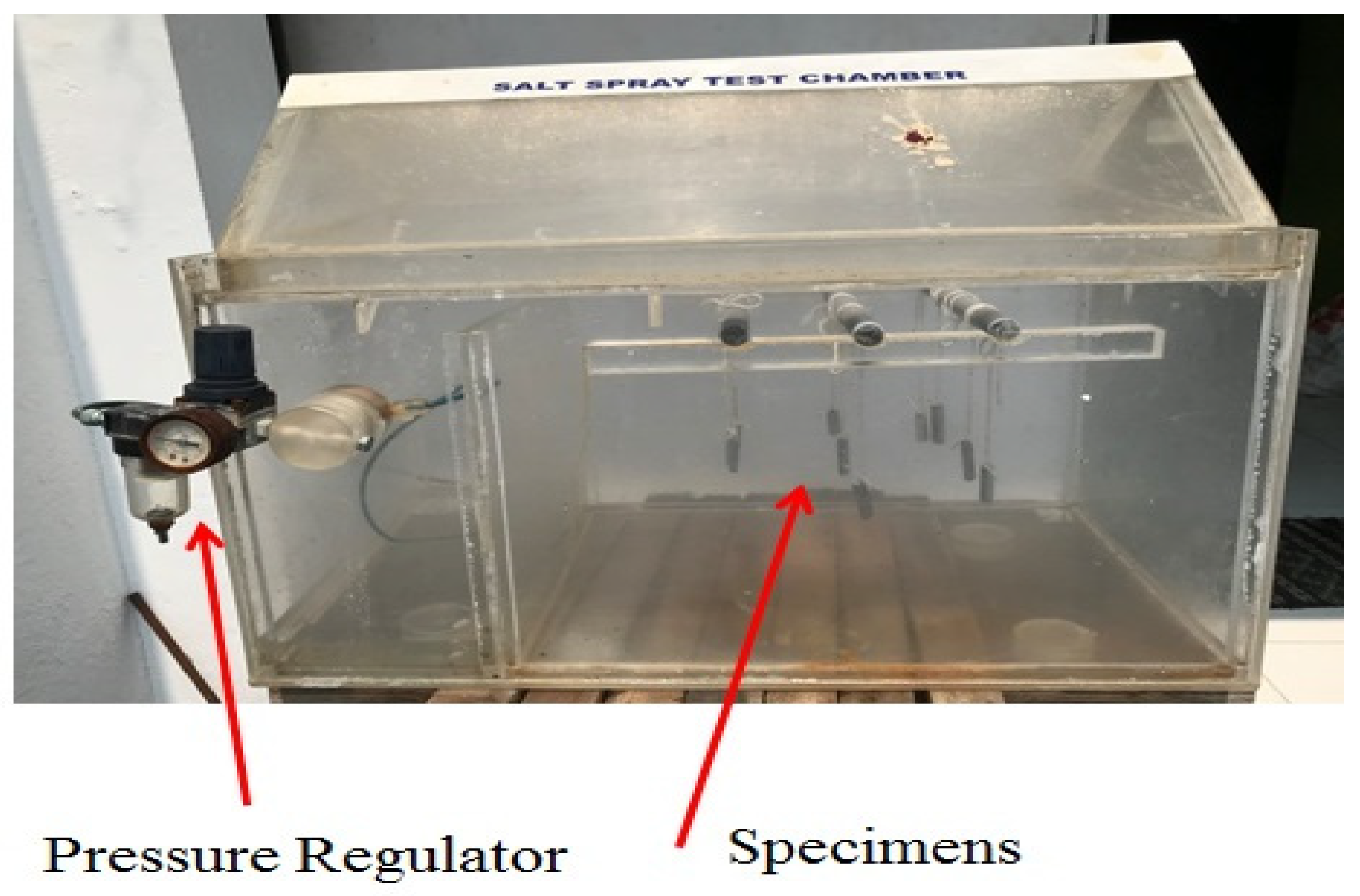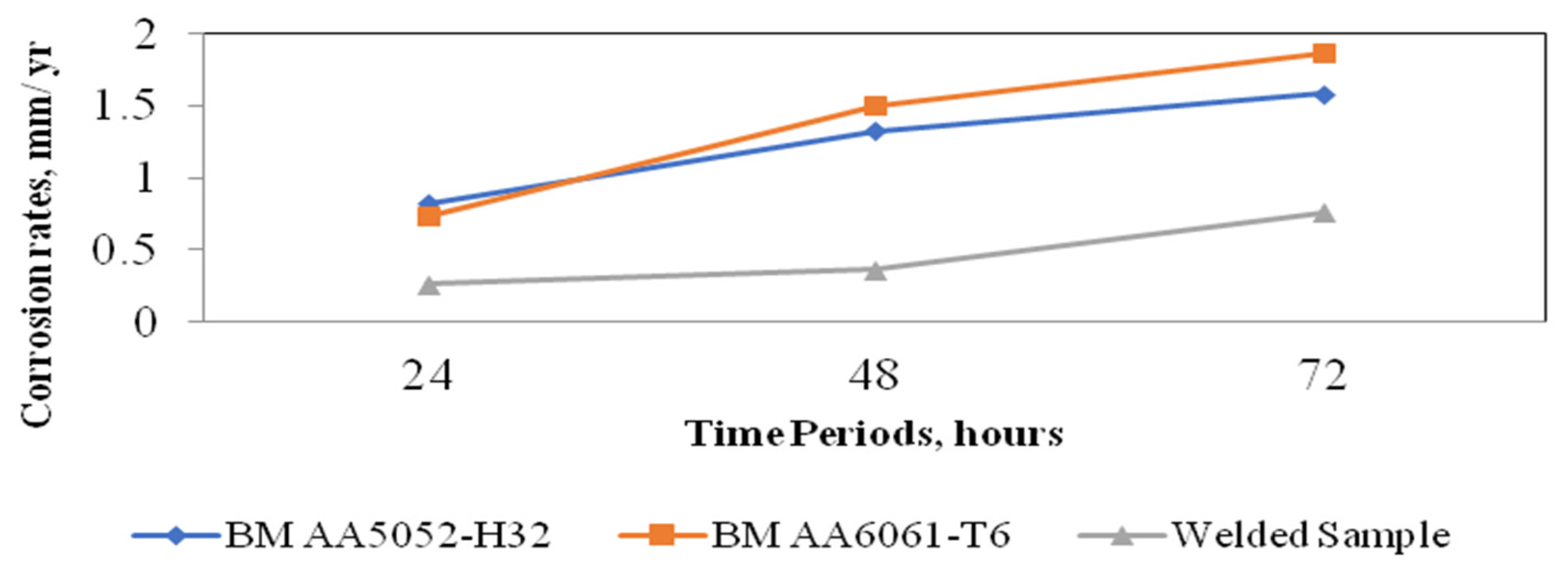Study of Friction Stir Welding Effects on the Corrosion Behaviour of Dissimilar Aluminium Alloys †
Abstract
:1. Introduction
2. Materials and Methods
3. Results
4. Discussion
Analysis of Corrosion Test Results
5. Conclusions
- The results of the SST are outlined. It was discovered that the level of corrosion in the welded area was the lowest (0.64734 mm/yr).
- The highest level of corrosion for AA5052-H32 was 1.58295 mm/yr, and the highest corrosion rate for AA6061-T6 was 1.86652 mm/yr.
- However, the SST revealed that the corrosion rate was found to be the lowest in the welding zone specimen as compared to the parent metals.
Author Contributions
Funding
Institutional Review Board Statement
Informed Consent Statement
Data Availability Statement
Conflicts of Interest
References
- Milagre, M.X.; Mogili, N.V.; Donatus, U.; Giorjão, R.A.; Terada, M.; Araujo, J.V.; Machado, C.S.; Costa, I. On the microstructure characterization of the AA2098-T351 alloy welded by FSW. Mater. Charact. 2018, 140, 233–246. [Google Scholar] [CrossRef]
- Balamurugan, S.; Jayakumar, K.; Subbaiah, K. Influence of friction stir welding parameters on dissimilar joints AA6061-T6 and AA5052-H32. Arab. J. Sci. Eng. 2021, 46, 11985–11998. [Google Scholar] [CrossRef]
- Moreto, J.A.; Dos Santos, M.S.; Ferreira, M.O.; Carvalho, G.S.; Gelamo, R.V.; Aoki, I.V.; Taryba, M.; Bose Filho, W.W.; Fernandes, J.C. Corrosion and corrosion-fatigue synergism on the base metal and nugget zone of the 2524-T3 Al alloy joined by FSW process. Corr. Sci. 2021, 182, 109253. [Google Scholar] [CrossRef]
- Senthamaraikannan, B.; Krishnamoorthy, J. Material flow and mechanical properties of friction stir welded AA 5052-H32 and AA6061-T6 alloys with Sc interlayer. Mater. Test 2023, 65, 1127–1142. [Google Scholar] [CrossRef]
- Balamurugan, S.; Jayakumar, K.; Anbarasan, B.; Rajesh, M. Effect of tool pin shapes on microstructure and mechanical behaviour of friction stir welding of dissimilar aluminium alloys. Mater. Today Proc. 2023, 72, 2181–2185. [Google Scholar] [CrossRef]
- Zhu, M.; Zhao, B.Z.; Yuan, Y.F.; Guo, S.Y.; Pan, J. Effect of solution temperature on the corrosion behavior of 6061-T6 aluminum alloy in NaCl solution. J. Mater. Eng. Perform. 2020, 29, 4725–4732. [Google Scholar] [CrossRef]
- Hariri, M.B.; Shiri, S.G.; Yaghoubinezhad, Y.; Rahvard, M.M. The optimum combination of tool rotation rate and traveling speed for obtaining the preferable corrosion behavior and mechanical properties of friction stir welded AA5052 aluminum alloy. Mater. Des. 2013, 50, 620–634. [Google Scholar] [CrossRef]
- Liu, P.; Sun, S.; Hu, J. Effect of laser shock peening on the microstructure and corrosion resistance in the surface of weld nugget zone and heat-affected zone of FSW joints of 7050 Al alloy. Opt. Laser Technol. 2019, 112, 1–7. [Google Scholar] [CrossRef]
- Rahimi, E.; Rafsanjani-Abbasi, A.; Imani, A.; Hosseinpour, S.; Davoodi, A. Correlation of surface Volta potential with galvanic corrosion initiation sites in solid-state welded Ti-Cu bimetal using AFM-SKPFM. Corr. Sci. 2018, 140, 30–39. [Google Scholar] [CrossRef]
- Gharavi, F.; Matori, K.A.; Yunus, R.; Othman, N.K.; Fadaeifard, F. Corrosion behavior of Al6061 alloy weldment produced by friction stir welding process. J. Mater. Res. Technol. 2015, 4, 314–322. [Google Scholar] [CrossRef]
- Donatus, U.; Thompson, G.E.; Zhou, X.; Wang, J.; Cassell, A.; Beamish, K. Corrosion susceptibility of dissimilar friction stir welds of AA5083 and AA6082 alloys. Mater. Charact. 2015, 107, 85–97. [Google Scholar] [CrossRef]
- Howeyze, M.; Arabi, H.; Eivani, A.R.; Jafarian, H.R. Strengthening of AA5052 aluminum alloy by equal channel angular pressing followed by softening at room temperature. Mater. Sci. Eng. A 2018, 720, 160–168. [Google Scholar] [CrossRef]
- Rajakumar, S.; Muralidharan, C.; Balasubramanian, V. Predicting tensile strength, hardness and corrosion rate of friction stir welded AA6061-T6 aluminium alloy joints. Mater. Des. 2011, 32, 2878–2890. [Google Scholar] [CrossRef]
- Bocchi, S.; Cabrini, M.; D’Urso, G.; Giardini, C.; Lorenzi, S.; Pastore, T. The influence of process parameters on mechanical properties and corrosion behavior of friction stir welded aluminum joints. J. Manuf. Process. 2018, 35, 1–5. [Google Scholar] [CrossRef]
- Babu, K.T.; Kumar, P.K.; Muthukumaran, S. Mechanical, metallurgical characteristics and corrosion properties of friction stir welded AA6061-T6 using commercial pure aluminium as a filler plate. Proc. Mater. Sci. 2014, 6, 648–655. [Google Scholar] [CrossRef]


| Sample Number | Sample Type | Weight before Corrosion (gram) | Weight after Corrosion (gram) | Weight Loss (gram) | Area (cm2) | Density (g/cm3) | Corrosion Rate × 10−4 (mm/year) | ||
|---|---|---|---|---|---|---|---|---|---|
| 24 h | 48 h | 72 h | |||||||
| 1 | PM AA5052-H32 | 3.186 | 3.159 | - | - | 0.027 | 145.35 | 2.7465 | 0.82233 |
| 2 | 3.802 | - | 3.758 | - | 0.044 | 145.66 | 2.7659 | 1.32906 | |
| 3 | 3.461 | - | - | 3.409 | 0.049 | 145.19 | 2.7527 | 1.58295 | |
| 1 | PM AA6061-T6 | 3.208 | 3.168 | - | - | 0.024 | 146.33 | 2.7080 | 0.73687 |
| 2 | 3.699 | - | 3.65 | - | 0.049 | 145.24 | 2.7287 | 1.50421 | |
| 3 | 3.985 | - | - | 3.924 | 0.059 | 144.98 | 2.7425 | 1.86652 | |
| 1 | 900 rpm 80 mm/min | 3.087 | 3.018 | - | - | 0.008 | 146.19 | 2.8360 | 0.26409 |
| 2 | 3.548 | - | 3.536 | - | 0.013 | 145.69 | 2.7655 | 0.35234 | |
| 3 | 3.794 | - | - | 3.77 | 0.019 | 144.98 | 2.7705 | 0.64734 | |
| 1 | 1000 rpm 80 mm/min | 3.087 | 3.018 | - | - | 0.008 | 146.19 | 2.8360 | 0.26409 |
| 2 | 3.548 | - | 3.536 | - | 0.013 | 145.69 | 2.7655 | 0.35234 | |
| 3 | 3.794 | - | - | 3.77 | 0.019 | 144.98 | 2.7705 | 0.64734 | |
| 1 | 1100 rpm 80 mm/min | 3.087 | 3.018 | - | - | 0.008 | 146.19 | 2.8360 | 0.26409 |
| 2 | 3.548 | - | 3.536 | - | 0.013 | 145.69 | 2.7655 | 0.35234 | |
| 3 | 3.794 | - | - | 3.77 | 0.019 | 144.98 | 2.7705 | 0.64734 | |
Disclaimer/Publisher’s Note: The statements, opinions and data contained in all publications are solely those of the individual author(s) and contributor(s) and not of MDPI and/or the editor(s). MDPI and/or the editor(s) disclaim responsibility for any injury to people or property resulting from any ideas, methods, instructions or products referred to in the content. |
© 2024 by the authors. Licensee MDPI, Basel, Switzerland. This article is an open access article distributed under the terms and conditions of the Creative Commons Attribution (CC BY) license (https://creativecommons.org/licenses/by/4.0/).
Share and Cite
Balamurugan, S.; Jayakumar, K.; Banu A, S.; Ragupathi, K. Study of Friction Stir Welding Effects on the Corrosion Behaviour of Dissimilar Aluminium Alloys. Eng. Proc. 2024, 61, 12. https://doi.org/10.3390/engproc2024061012
Balamurugan S, Jayakumar K, Banu A S, Ragupathi K. Study of Friction Stir Welding Effects on the Corrosion Behaviour of Dissimilar Aluminium Alloys. Engineering Proceedings. 2024; 61(1):12. https://doi.org/10.3390/engproc2024061012
Chicago/Turabian StyleBalamurugan, Senthamaraikannan, Krishnamoorthy Jayakumar, Sajitha Banu A, and Kandasamy Ragupathi. 2024. "Study of Friction Stir Welding Effects on the Corrosion Behaviour of Dissimilar Aluminium Alloys" Engineering Proceedings 61, no. 1: 12. https://doi.org/10.3390/engproc2024061012





